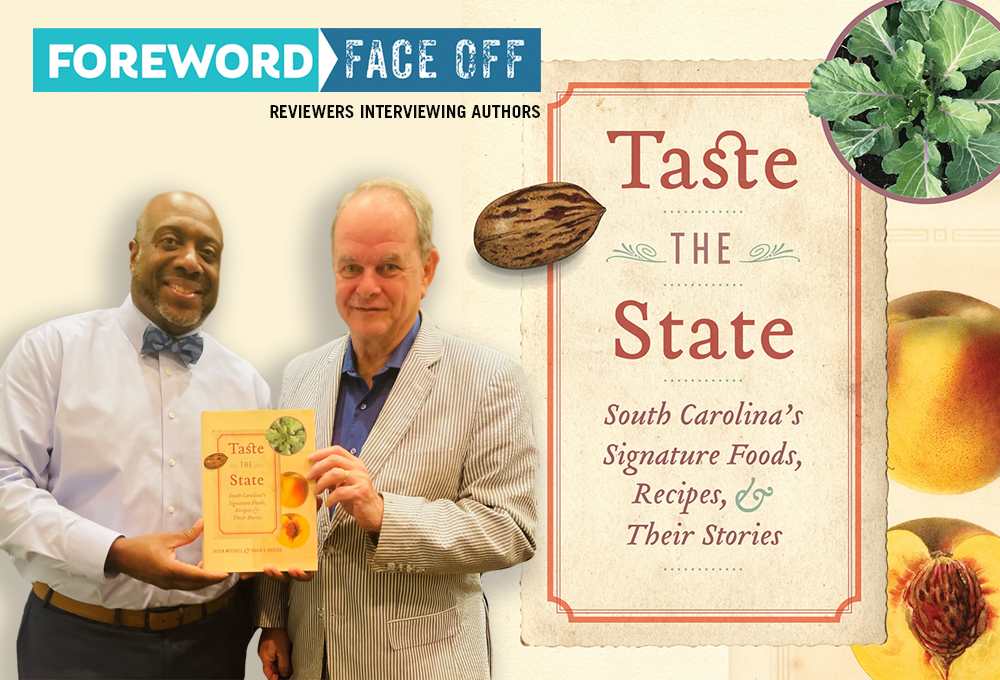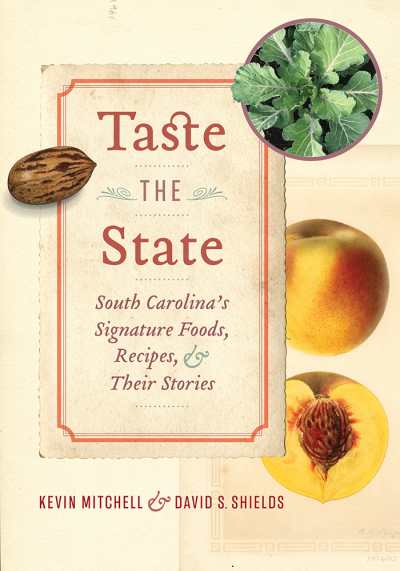Reviewer Rachel Jagareski Interviews Kevin Mitchell and David S. Shields, Authors of Taste the State: South Carolina’s Signature Foods, Recipes, and Their Stories

Cross this grand land of ours and you’ll scarcely find a more culturally rich region than South Carolina—with its strong African and Caribbean influences, bountiful coastal waters, and three hundred-plus years of adventurous cooking history to hone a distinctive Southern cuisine. This week, we’re thrilled to learn more about The Palmetto State’s food scene from Kevin Mitchell and David S. Shields, new authors of Taste the State: South Carolina’s Signature Foods, Recipes, and Their Stories—which earned a starred review from in Foreword’s September/October issue from Rachel Jagareski.

Thanks to the good people at The University of South Carolina Press for help in making the connection.
Your book engagingly blends social history and a well-illustrated tour of South Carolina’s rich historic and contemporary foodways. It was wonderful to read a culinary book that seamlessly showcases your skills as educators, writers, and cooks. When you were planning and writing Taste the State, how did you divvy up the research and writing for each entry?
We began first listing all the things we could think of that might be in the book—we had as many as 140 items—and then we looked at those and asked which ones were particular to SC, and which were generically Southern. So things like fried chicken, moon pies, crab cakes, and pecan pie were jettisoned. Then there was a range of items, like pimento cheese, that are surely used and cherished in SC, but are more connected with other states (Georgia grows the Perfection Pimento Pepper, the base for pimento cheese).
When we had about 85 foods finally selected we began to divvy up items based on interest or expertise. Kevin did the African diaspora elements. David did the agricultural history items. Some items required inputs from both of us. Since each had the right to alter the other’s entry, there was no embarrassment about going in and tweaking or supplementing something to make it more informative and entertaining.
Your documentation of the contributions of enslaved and Indigenous cooks, vendors, and food producers was important and fascinating information. How challenging was it to uncover this culinary history and what sources proved most useful?
There’s more out there than you might suspect. Lots of information is contained in old agricultural journals, in newspaper stories, and in family oral traditions that have been passed down. The WPA interviews of formerly enslaved people provide a great range of information. David had extensive dealings with certain of the Native Peoples in the state.
I was intrigued to learn that South Carolina was a “truck farming power” in the days before refrigeration enabled long-distance transportation of perishable foods. Do you think that the current trend toward greater appreciation of local produce will continue to grow and encourage farmers to cultivate more of the distinctive heirloom and native varieties you discuss in your book? Will we be seeing more loquats, Jerusalem artichokes, persimmons, and Palmetto asparagus in supermarkets across the country?
There are forces at work right now that are moving things in the direction of diverse produce; for example, Clemson University’s Southern Heritage Crops initiative. We will see more Charleston Wakefield Cabbage in the near future. We’re fans of farmers markets and produce marts. National grocery chains sometimes don’t pay enough for the heirloom material that is more difficult and costly to grow.
Your book notes the effects that pollution and overharvesting have had on some signature South Carolina foods, like Sea Island conch, which locals have kept on the down low as “they know what happens when an ingredient becomes fashionable.” Do you envision a time when there might be more state environmental and fishing regulation or is that just too unpopular to contemplate?
There have been fishing and game regulations since the mid-19th century. Shad was one of the first protected fish. No one complains that the Atlantic Sturgeon is protected. Some things like the Diamondback Terrapin are in a perilous place and stopping harvesting was the only recourse. We like it when certain imperiled things come back, like the Guinea Hog, and hope that someday we will be able to feast on Rice Birds again.
There is felicitous charm to so many recipe names—Chicken Bog, Pine Bark Stew, Limping Susan, Red Horse Bread—just to name a few. What cultural wellspring does this emanate from?
There is a fanciful turn in Southern language and a penchant for figural speech. It isn’t simply the preserve of the Eudora Weltys and Ron Rashes—fiction writers. Some of the wildest notions appear on hand lettered ad signs or on church marquees.
You discuss a Southern culinary revival that you limit to 2000–2010. Do you think that interest in Southern cooking has waned in the last decade?
We date the Southern culinary revival more from 2007–2017 if you want to speak of a 10-year period. This differed from previous moments of Southern culinary efflorescence in that it resulted in the nationalization of Southern food. Within Southern Food in 2021, there seems to be several inflections: a turn toward the more explicitly African diaspora cooking, the spread of barbeque joints nationally, and various sub regional styles. We haven’t yet seen the much-prophesied Latin-Southern fusion in our region, although some of the best cooks are Latino.
The contrast is noteworthy between recipes culled from historic cookbooks and newspapers and Chef Mitchell’s updated versions. As you were developing these recipes, I am sure you anticipated sharing them at food festivals, markets, and other venues. How has the current COVID pandemic affected your book promotion activities?
The book was originally scheduled to publish earlier in the year but the virus delayed publication to October. But COVID hasn’t had a major effect on the promotion of the book. The University of South Carolina Press has done a fantastic job with promoting the book in every angle possible. We have an impressive lineup of events scheduled in South Carolina, including a dinner for Kevin with the South Carolina Chef Ambassador program in Charleston, and food events throughout the state, plus traditional bookstore signings, and a few virtual events as well.
Rachel Jagareski
